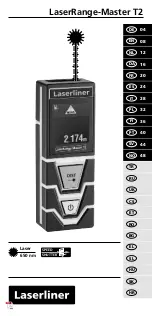
22
SECTION 8.0 DIAGNOSTICS AND TROUBLESHOOTING
TABLE 8-2. RTD Resistance Values
TABLE 8-1. Diagnostic Messages
Temperature
Resistance
0
°
C
100.00 ohms
10°C
103.90 ohms
20°C
107.79 ohms
30°C
111.67 ohms
40°C
115.54 ohms
50°C
119.40 ohms
60°C
123.24 ohms
70°C
127.07 ohms
80°C
130.89 ohms
90°C
134.70 ohms
100°C
138.50 ohms
Display
Description
Corrective Action
“
SLP
–
FAIL
”
Electrode slope out of limits
See
Table 8-5
“
FAIL
”
Transmitter electronics failure
See
Table 8-5
“
rngE
–
LOOP
” pH value outside 4-20 mA range points
Return pH to within range, replace sensor
“
SnSr
–
FAIL
” Sensor failure or A-D failure
See
Table 8-5
“
tEnP
–
Lo
”
Temperature too low or RTD shorted
Check wiring, calibrate temperature, bring sensor within
“
tEnP
–
Hi
”
Temperature too high or RTD open
temperature specifications, replace stack, replace sensor.
Note: If in manual temp. mode, RTD or appropriate resistor
must be in place. See
Table 8-2
.
MODEL 2081 pH
SECTION 8.0
DIAGNOSTICS AND TROUBLESHOOTING
8.1 DIAGNOSTICS.
The transmitter has a diagnostic
feature which continuously monitors for fault condi-
tions that would cause an error in the measured pH
value. A fault condition is reported to the current loop
as jumper selected. If jumper JP3 in in place, the out-
put will be driven below 4 mA. If the jumper is not in
place, the output will be driven above 20 mA. See
Figure 1-3
for jumper location. The display will alter-
nate between the pH value and the appropriate fault
mnemonic (
Table 8-1
). The fault sequence will contin-
ue until the cause of the fault has been corrected.
8.1.1 Diagnostic Messages.
Table 8-1
lists the fault dis-
play, discribes the meaning of each and appropriate
corrective action. All of these faults are detected
online, except for the slope error which can occur dur-
ing an off-line buffer calibration.
8.1.2 Temperature Compensation.
Table 8-2
is a refer-
ence of RTD resistance values at various temperatures.
These are used for test and evaluation of the sensor.
NOTE
Ohmic values are read across the RTD ele-
ment and are based on the manufacturer’s
stated values (±1%). Allow enough time for the
RTD element to stabilize to the surrounding
temperature.
8.2 TROUBLESHOOTING.
The Model 2081 pH trans-
mitter is designed with state-of-the-art surface mount
technology and microprocessor technology, making
troubleshooting simple and direct. Subassembly
replacement, i.e. PCB stack replacement, is all that is
required.
NOTE
Transmitters should not be left in service once
they have been determined to be inoperable.
8.2.1 General.
If failure does occur, complete the fol-
lowing steps:
1.
Check for a fault flag. If a fault condition exists, refer
to
Table 8-1
for the fault mnemonic explanation.
2.
Check wiring connections for proper installation.
3.
Refer to Troubleshooting
Table 8-5
. The table is
arranged with the most common problems listed
first.
Summary of Contents for 2081 pH
Page 36: ...FOLD ALONG DOTTED LINES ...














































